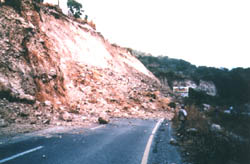|
 Hemispheric
Plan for Environmental Management Guidance of Road Transportation Corridors Hemispheric
Plan for Environmental Management Guidance of Road Transportation Corridors
 The
Unit for Sustainable Development and Environment (USDE) supports the member
states of the OAS in promoting trade corridor development —an emerging
regional planning unit— by contributing to an understanding of environmental
concerns related to road corridors, identifying existing knowledge and
expertise in the region, and promoting corridor development which is resilient
to natural hazards. Transportation corridors are important in light of
the increasing number and complexity of trade agreements being signed
in the Americas, and the resulting increase in transported goods. The
Unit for Sustainable Development and Environment (USDE) supports the member
states of the OAS in promoting trade corridor development —an emerging
regional planning unit— by contributing to an understanding of environmental
concerns related to road corridors, identifying existing knowledge and
expertise in the region, and promoting corridor development which is resilient
to natural hazards. Transportation corridors are important in light of
the increasing number and complexity of trade agreements being signed
in the Americas, and the resulting increase in transported goods.
The Hemispheric Plan
for Environmental Management Guidance of Road Transportation Corridors
is a guide to establishing policy, procedures, and standards based on
the experiences to date of OAS member states in the environmental management
of road corridors.
The Plan is divided
into four areas: 1) a handbook containing policies, planning processes
or procedures, projects (case studies), and preparedness for emergencies;
2) an annotated bibliography; 3) a matrix classifying the documents in
the bibliography; and 4) a section on the implementation and development
of the Plan.
The Handbook comprises five chapters. Chapter 1 is the Introduction; Chapter
2 discusses the institutional reorganizations required to ensure effective
environmental management of transport corridors, and then assesses the
policies needed for implementing this form of environmental management.
Chapter 3 deals with environmental-management planning and looks at mitigation
measures to reduce the direct and indirect environmental impact on roads;
it also analyzes the existing guidelines for producing Environmental Impact
Assessments (EIAs) to determine the vulnerability to natural hazards of
road corridors in Latin America. Chapter 4 discusses the application of
guidelines on environmental management of road corridors, and presents
case studies illustrating one or more of the guidelines. Chapter 5 deals
with emergency preparedness as part of the environmental management of
trade corridors.
The guidelines cover
the best ways of responding to emergencies caused by natural hazards as
well as man-made disasters related to industrial accidents or the transport
of hazardous materials.
The Annotated Bibliography is a database of documents that have been prepared
by the Unit for Sustainable Development and Environment, the Natural Hazards
Project and others in the areas of transportation corridor vulnerability
mitigation and the environmental management of transportation corridors.
It includes handbooks, periodical publications, research papers, conference
proceedings, technical and policy guidelines, standards, and regulations.
The Matrix complements the Bibliography by defining the issues covered
in the documents in the Bibliography and listing the appropriate references.
The section on the
implementation and development of the Plan presents the actions needed
to:
- Complete the drafting
of the Environmental Management Guidebook.
- Prepare an executive
summary of the Plan to promote its key concepts.
- Establish the
committees needed to guide the completion of the Plan and the drafting
of the executive summary.
- Develop follow-up
mechanisms for the Plan and its components.
During the Fourth
Ibero-American Meeting of Environmental Units in the Transport Sector,
held on 19-24 November 2000 in Santa Cruz de la Sierra, Bolivia, the Unit
for Sustainable Development and Environment of the OAS (OAS/USDE) transferred
to the Latin American Society of Environmental Units in the Transport
Sector (SLUAT) the mandate to continue coordinating the production of
the final draft of the Hemispheric Plan. SLUAT delegated the task to a
Plan Advisory Committee (CAPLAN) that will be in charge of disseminating
the document, revising it, and collecting feedback on it. The Committee
is made up of representatives from several countries and international
organizations, and is currently working on revising the Guidebook and
incorporating new methodologies into the final draft.
For more information, please contact:
Unit for Sustainable Development and Environment
of the Organization of American States (OAS/USDE)
www.oas.org/nhp
|




